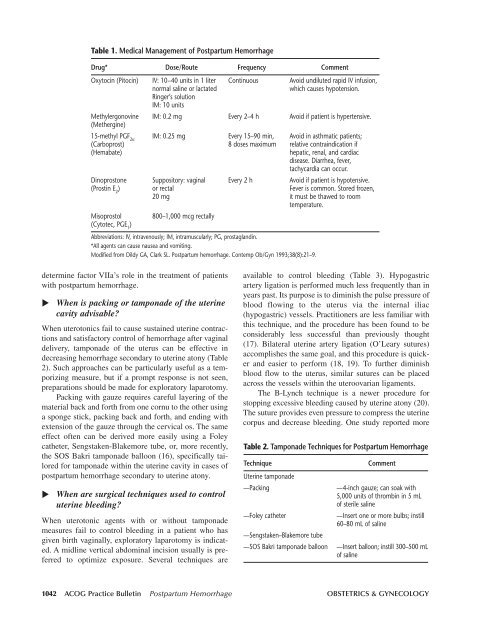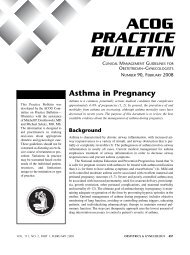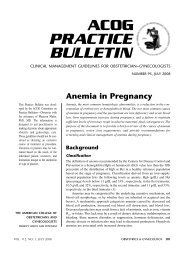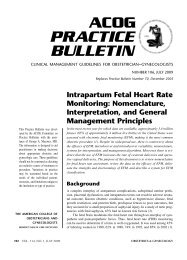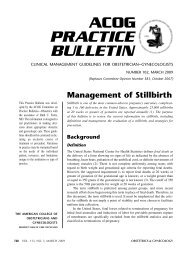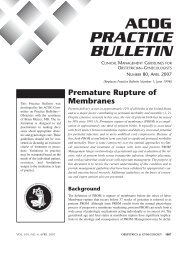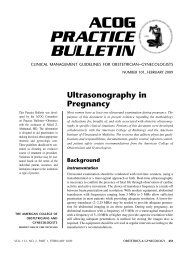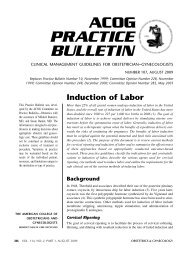ACOG Practice Bulletin No. 76: Postpartum Hemorrhage
ACOG Practice Bulletin No. 76: Postpartum Hemorrhage
ACOG Practice Bulletin No. 76: Postpartum Hemorrhage
You also want an ePaper? Increase the reach of your titles
YUMPU automatically turns print PDFs into web optimized ePapers that Google loves.
Table 1. Medical Management of <strong>Postpartum</strong> <strong>Hemorrhage</strong><br />
Drug* Dose/Route Frequency Comment<br />
Oxytocin (Pitocin) IV: 10–40 units in 1 liter Continuous Avoid undiluted rapid IV infusion,<br />
normal saline or lactated<br />
which causes hypotension.<br />
Ringer’s solution<br />
IM: 10 units<br />
Methylergonovine IM: 0.2 mg Every 2–4 h Avoid if patient is hypertensive.<br />
(Methergine)<br />
15-methyl PGF 2α<br />
IM: 0.25 mg Every 15–90 min, Avoid in asthmatic patients;<br />
(Carboprost) 8 doses maximum relative contraindication if<br />
(Hemabate)<br />
hepatic, renal, and cardiac<br />
disease. Diarrhea, fever,<br />
tachycardia can occur.<br />
Dinoprostone Suppository: vaginal Every 2 h Avoid if patient is hypotensive.<br />
(Prostin E 2<br />
) or rectal Fever is common. Stored frozen,<br />
20 mg it must be thawed to room<br />
temperature.<br />
Misoprostol<br />
800–1,000 mcg rectally<br />
(Cytotec, PGE 1<br />
)<br />
Abbreviations: IV, intravenously; IM, intramuscularly; PG, prostaglandin.<br />
*All agents can cause nausea and vomiting.<br />
Modified from Dildy GA, Clark SL. <strong>Postpartum</strong> hemorrhage. Contemp Ob/Gyn 1993;38(8):21–9.<br />
determine factor VIIa’s role in the treatment of patients<br />
with postpartum hemorrhage.<br />
▲ ▲<br />
When is packing or tamponade of the uterine<br />
cavity advisable<br />
When uterotonics fail to cause sustained uterine contractions<br />
and satisfactory control of hemorrhage after vaginal<br />
delivery, tamponade of the uterus can be effective in<br />
decreasing hemorrhage secondary to uterine atony (Table<br />
2). Such approaches can be particularly useful as a temporizing<br />
measure, but if a prompt response is not seen,<br />
preparations should be made for exploratory laparotomy.<br />
Packing with gauze requires careful layering of the<br />
material back and forth from one cornu to the other using<br />
a sponge stick, packing back and forth, and ending with<br />
extension of the gauze through the cervical os. The same<br />
effect often can be derived more easily using a Foley<br />
catheter, Sengstaken-Blakemore tube, or, more recently,<br />
the SOS Bakri tamponade balloon (16), specifically tailored<br />
for tamponade within the uterine cavity in cases of<br />
postpartum hemorrhage secondary to uterine atony.<br />
When are surgical techniques used to control<br />
uterine bleeding<br />
When uterotonic agents with or without tamponade<br />
measures fail to control bleeding in a patient who has<br />
given birth vaginally, exploratory laparotomy is indicated.<br />
A midline vertical abdominal incision usually is preferred<br />
to optimize exposure. Several techniques are<br />
available to control bleeding (Table 3). Hypogastric<br />
artery ligation is performed much less frequently than in<br />
years past. Its purpose is to diminish the pulse pressure of<br />
blood flowing to the uterus via the internal iliac<br />
(hypogastric) vessels. Practitioners are less familiar with<br />
this technique, and the procedure has been found to be<br />
considerably less successful than previously thought<br />
(17). Bilateral uterine artery ligation (O’Leary sutures)<br />
accomplishes the same goal, and this procedure is quicker<br />
and easier to perform (18, 19). To further diminish<br />
blood flow to the uterus, similar sutures can be placed<br />
across the vessels within the uteroovarian ligaments.<br />
The B-Lynch technique is a newer procedure for<br />
stopping excessive bleeding caused by uterine atony (20).<br />
The suture provides even pressure to compress the uterine<br />
corpus and decrease bleeding. One study reported more<br />
Table 2. Tamponade Techniques for <strong>Postpartum</strong> <strong>Hemorrhage</strong><br />
Technique<br />
Uterine tamponade<br />
—Packing<br />
—Foley catheter<br />
—Sengstaken–Blakemore tube<br />
—SOS Bakri tamponade balloon<br />
Comment<br />
—4-inch gauze; can soak with<br />
5,000 units of thrombin in 5 mL<br />
of sterile saline<br />
—Insert one or more bulbs; instill<br />
60–80 mL of saline<br />
—Insert balloon; instill 300–500 mL<br />
of saline<br />
1042 <strong>ACOG</strong> <strong>Practice</strong> <strong>Bulletin</strong> <strong>Postpartum</strong> <strong>Hemorrhage</strong> OBSTETRICS & GYNECOLOGY


